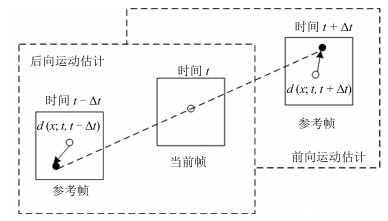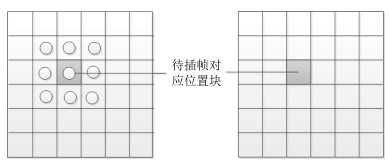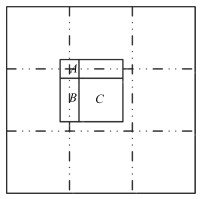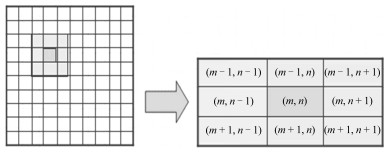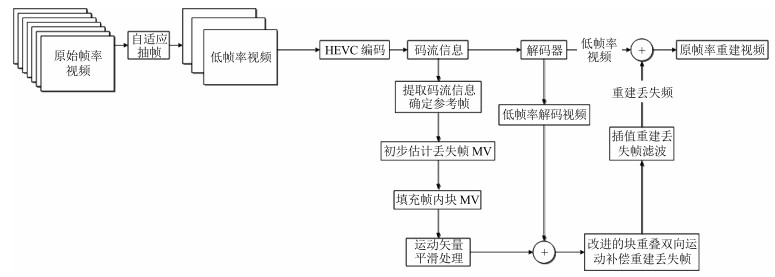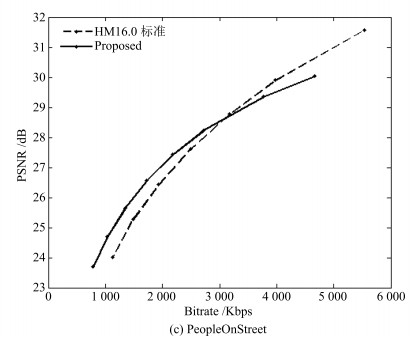A New Video Compression Encoding Algorithm Combining Frame Rate Conversion With HEVC Standard
-
摘要: 相比于之前主流的H.264视频压缩编码标准,HEVC在保证重建视频质量相同的前提下,可以将码率降低近50%,节省了传输所需的带宽.即便如此,由于一些特定的网络带宽限制,为继续改善HEVC视频编码性能,进一步提升对视频的压缩效率仍然是当前研究的热点.本文提出一种HEVC标准编码与帧率变换方法相结合的新型的视频压缩编码算法,首先在编码端,提出一种自适应抽帧方法,降低原视频帧率,减少所需传输数据量,对低帧率视频进行编解码;在解码端,结合从HEVC传输码流中提取的运动信息以及针对HEVC编码特定的视频帧的分块模式信息等,对丢失帧运动信息进行估计;最后,通过本文提出的改进基于块覆盖双向运动补偿插帧方法对视频进行恢复重建.实验结果证实了本文所提算法的有效性.Abstract: Compared to the video coding standard H.264, the bit rate of HEVC can be reduced nearly by 50% with the same quality of reconstructed video. So HEVC can greatly save the bandwidth used for transmission. Even so, the transmission of video is still subject to the bandwidth of some special network. In order to further enhance the performance of HEVC, the work of further enhancing the video compression ratio is a hot issue. This paper proposes a new algorithm for video coding that combines HEVC with the technique of frame rate conversion. First, on the encoding side, the paper puts forward an adaptive frame-skip scheme to reduce the original video frame rate, so that the requirement for transmitting data is reduced. Then, the low frame rate video is encoded. On the decoding side, the algorithm uses the information of motion vector and special pattern of block for encoded video frames, which are extracted from the HEVC transmission stream, to reconstruct the video. Moreover, this algorithm can estimate the motion vector of the missing frames. Finally, the algorithm reconstructs the video using the proposed method based on block cover bidirectional motion compensation interpolation. Experimental results confirm the effectiveness of the proposed algorithm.
-
Key words:
- Frame rate conversion /
- HEVC /
- adaptive frame-skip /
- block coverage /
- motion compensation interpolation
-
-
表 1 本文算法与标准HM16.0码率及PSNR对比
Table 1 The comparison of bitrate and PSNR about proposed method and HM16.0
序列名称 QP HM16.0编码方法 本文算法 码率(Kbps) PSNR (dB) 码率(Kbps) PSNR (dB) Mobisode2_416 $\times$ 240 22 153.889 46.1768 116.31 44.284 27 102.877 44.5633 77.76 43.249 32 55.993 42.0227 42.115 41.339 37 32.224 39.5469 23.534 39.143 42 20.647 37.3411 14.99 37 PartyScene_832 $\times$ 480 22 5 498.261 34.1461 3 575.072 31.5 27 3 432.89 32.0024 2 287.624 30.084 32 1 527.853 28.6774 1 060.824 27.703 37 666.784 25.6876 475.32 25.263 42 303.951 23.5107 222.064 23.321 FourPeople_1280 $\times$ 720 22 2 787.105 42.447 2 007.235 41.766 27 1 488.774 41.1869 1 165.056 40.699 32 715.817 38.8563 595.181 38.57 37 387.899 36.0701 329.453 35.924 42 216.284 33.02 183.034 32.927 ParkScene_1920 $\times$ 1 080 22 5 332.273 38.1731 3 736.08 36.742 27 2 266.56 35.4312 1 613.404 34.566 32 700.955 31.8568 512.072 31.449 37 291.668 29.5234 215.176 29.296 42 134.253 27.8972 98.776 27.757 PeopleOnStreet_2 560 $\times$ 1 600 22 9 743.635 34.3938 6 512.658 31.08 27 5 535.946 31.5666 3 768.415 29.343 32 3 166.589 28.7697 2 181.695 27.431 37 1 934.102 26.4274 1 343.4 25.644 42 1 126.626 24.0122 785.935 23.687 表 2 本文算法与标准HEVC码率节省对比
Table 2 The comparison of rate saving for proposed method and HEVC
序列名称 Mobisode2 PartyScene FourPeople ParkScene PeopleOnStreet 平均值 BD-rate (%) $-$14.8264 $-$12.3977 $-$11.5055 $-$15.1996 $-$12.0341 $-$13.1927 表 3 不同算法重建视频平均PSNR (dB)
Table 3 The average PSNR (dB) value of video reconstructed with different methods
序列名称 传统双向运动补偿插帧 文献[9] 本文算法 FourPeople 37.0147 37.3283 37.9772 ParkScene 31.125 31.4167 31.962 Mobile 26.7794 28.3065 28.6146 Tennis 30.1366 30.4844 30.7237 表 4 编码时间效率对比
Table 4 The comparison of coding time
序列名称 QP (dB) 标准HM16.0编码时间(s) 本文算法时间(s) $\Delta T$ (%) PartyScene_832 $\times$ 480 22 10717.161 5 892.436 $-$45.02 27 7 868.587 4 714.987 $-$40.08 32 5 986.152 3 403.753 $-$43.14 37 4 875.39 2 784.821 $-$42.88 42 4 057.444 2 211.079 $-$45.51 FourPeople_1 280 $\times$ 720 22 9 724.638 5 338.595 $-$45.1 27 7 885.048 4 838.479 $-$38.64 32 7 171.39 3 917.959 $-$45.37 37 6 850.932 3 673.508 $-$46.38 42 6 492.365 3 571.843 $-$44.98 ParkScene_1 920 $\times$ 1 080 22 36 263.066 19 216.03 $-$47.01 27 25 401.101 15 042.524 $-$40.78 32 20 704.785 11 547.355 $-$44.23 37 18 175.229 9 847.318 $-$45.82 42 16 256.87 8 745.239 $-$46.21 PeopleOnStreet_2 560 $\times$ 1 600 22 51 921.735 28 433.679 $-$45.24 27 39 493.22 23 313.14 $-$40.97 32 32 649.236 17 791.625 $-$45.51 37 28 675.298 15 602.986 $-$45.59 42 24 987.769 13 700.208 $-$45.17 平均 $-$44.1815 -
[1] Lee S H, Shin Y C, Yang S, Moon H H, Park R H. Adaptive motion-compensated interpolation for frame rate up-conversion. IEEE Transactions on Consumer Electronics, 2002, 48 (3):444-450 doi: 10.1109/TCE.2002.1037026 [2] Hilman K, Park H W, Kim Y M. Using motion-compensated frame-rate conversion for the correction of 3:2 pulldown artifacts in video sequences. IEEE Transactions on Circuits and Systems for Video Technology, 2000, 10 (6):869-877 doi: 10.1109/76.867925 [3] Kim D, Park H. An efficient motion-compensated frame interpolation method using temporal information for high-resolution videos. Journal of Display Technology, 2015, 11 (7):580-588 doi: 10.1109/JDT.2015.2417313 [4] Tsai T H, Shi A T, Huang K T. Accurate frame rate up-conversion for advanced visual quality. IEEE Transactions on Broadcasting, 2016, 62 (2):426-435 doi: 10.1109/TBC.2016.2550764 [5] Choi B T, Lee S H, Ko S J. New frame rate up-conversion using bi-directional motion estimation. IEEE Transactions on Consumer Electronics, 2000, 46 (3):603-609 doi: 10.1109/30.883418 [6] Choi B D, Han J W, Kim C S, Ko S J. Motion-compensated frame interpolation using bilateral motion estimation and adaptive overlapped block motion compensation. IEEE Transactions on Circuits and Systems for Video Technology, 2007, 17 (4):407-416 doi: 10.1109/TCSVT.2007.893835 [7] Kang S J, Cho K R, Kim Y H. Motion compensated frame rate up-conversion using extended bilateral motion estimation. IEEE Transactions on Consumer Electronics, 2007, 53 (4):1759-1767 doi: 10.1109/TCE.2007.4429281 [8] Kang S J, Yoo S J, Kim Y H. Dual motion estimation for frame rate up-conversion. IEEE Transactions on Circuits and Systems for Video Technology, 2010, 20 (12):1909-1914 doi: 10.1109/TCSVT.2010.2087832 [9] Hu H P, Liu G Y. A novel method for frame rate up-conversion. In: Proceedings of the 2011 International Conference on Image Analysis and Signal Processing (IASP). Wuhan, China: IEEE, 2011. 6-9 [10] Inseo H, Ho S J, Myung H S. A new motion compensated frame interpolation algorithm using adaptive motion estimation. Journal of the Institute of Electronics and Information Engineers, 2015, 52 (6):62-69 doi: 10.5573/ieie.2015.52.6.062 [11] Xu C, Chen Y Q, Gao Z Y, Ye Y Z, Shan T. Frame rate up-conversion with true motion estimation and adaptive motion vector refinement. In: Proceedings of the 4th International Congress on Image and Signal Processing (CISP). Shanghai, China: IEEE, 2011. 353-356 [12] Cao Y Z H, He X H, Teng Q Z, Wu W. Motion compensated frame rate up-conversion using soft-decision motion estimation and adaptive-weighted motion compensated interpolation. Journal of Computational Information Systems, 2013, 9 (14):5789-5797 [13] Kaviani H R, Shirani S. Frame rate upconversion using optical flow and patch-based reconstruction. IEEE Transactions on Circuits and Systems for Video Technology, 2016, 26 (9):1581-1594 doi: 10.1109/TCSVT.2015.2469120 [14] Lee W H, Choi K, Ra J B. Frame rate up conversion based on variational image fusion. IEEE Transactions on Image Processing, 2014, 23 (1):399-412 doi: 10.1109/TIP.2013.2288139 [15] 孙琰玥, 何小海, 宋海英, 陈为龙.一种用于视频超分辨率重建的块匹配图像配准方法.自动化学报, 2011, 37(1):37-43 http://www.aas.net.cn/CN/abstract/abstract17404.shtmlSun Yan-Yue, He Xiao-Hai, Song Hai-Ying, Chen Wei-Long. A block-matching image registration algorithm for video super-resolution reconstruction. Acta Automatica Sinica, 2011, 37 (1):37-43 http://www.aas.net.cn/CN/abstract/abstract17404.shtml [16] Kim U S, Sunwoo M H. New frame rate up-conversion algorithms with low computational complexity. IEEE Transactions on Circuits and Systems for Video Technology, 2014, 24 (3):384-393 doi: 10.1109/TCSVT.2013.2278142 [17] 鲁志红, 郭丹, 汪萌.基于加权运动估计和矢量分割的运动补偿内插算法.自动化学报, 2015, 41 (5):1034-1041 http://www.aas.net.cn/CN/abstract/abstract18677.shtmlLu Zhi-Hong, Guo Dan, Wang Meng. Motion-compensated frame interpolation based on weighted motion estimation and vector segmentation. Acta Automatica Sinica, 2015, 41 (5):1034-1041 http://www.aas.net.cn/CN/abstract/abstract18677.shtml [18] 马名浪, 何小海, 滕奇志, 陈洪刚, 卿粼波.基于自适应稀疏变换的指纹图像压缩.自动化学报, 2016, 42 (8):1274-1284 http://www.aas.net.cn/CN/abstract/abstract18916.shtmlMa Ming-Lang, He Xiao-Hai, Teng Qi-Zhi, Chen Hong-Gang, Qing Lin-Bo. Fingerprint image compression algorithm via adaptive sparse transformation. Acta Automatica Sinica, 2016, 42 (8):1274-1284 http://www.aas.net.cn/CN/abstract/abstract18916.shtml [19] Hong B, Eom M, Choe Y. Scene change detection using edge direction based on intra prediction mode in H.264/AVC compression domain. In: Proceedings of the 2006 IEEE Region 10 Conference. Hong Kong, China: IEEE, 2006. 1-4 [20] Yan C G, Zhang Y D, Xu J Z, Dai F, Zhang J, Dai Q H, Wu F. Efficient parallel framework for HEVC motion estimation on many-core processors. IEEE Transactions on Circuits and Systems for Video Technology, 2014, 24 (12):2077-2089 doi: 10.1109/TCSVT.2014.2335852 [21] Heithausen C, Vorwerk J H. Motion compensation with higher order motion models for HEVC. In: Proceedings of the 2015 IEEE International Conference on Acoustics, Speech, and Signal Processing (ICASSP). South Brisbane, QLD, Australia: IEEE, 2015. 1438-1442 [22] Lee S H, Kwon O, Park R H. Weighted-adaptive motion-compensated frame rate up-conversion. IEEE Transactions on Consumer Electronics, 2003, 49 (3):485-492 doi: 10.1109/TCE.2003.1233759 [23] Song H B, Men A D, Shi G J. A method for halo artifact reduction in MEMC. In: Proceedings of the 2009 Digest of Technical Papers International Conference on Consumer Electronics. Las Vegas, NV, USA: IEEE, 2009. 1-2 期刊类型引用(15)
1. 耿艳利,刘松岳,王希瑞,宣伯凯. 电动下肢假肢多路况控制策略研究. 中国康复医学杂志. 2024(02): 226-231 .  百度学术
百度学术2. 汪晓铭,黎林荣,陈长龙,孙洁,张哲文,孟巧玲,喻洪流. 人-机-环境共融的智能假肢膝关节研究进展. 中国生物医学工程学报. 2023(04): 486-501 .  百度学术
百度学术3. 韩亚丽,韩子,金壮壮,徐闽海,吴应达. 一种主动型踝关节助力外骨骼设计及性能实验. 仪器仪表学报. 2023(11): 109-118 .  百度学术
百度学术4. 刘克平,滕召纬,孙中波,李婉婷. 基于自适应模糊神经网络的下肢关节角度估计. 计算机仿真. 2022(09): 456-461 .  百度学术
百度学术5. 盛敏,唐少波. 融合统计和几何特征的运动意图识别方法. 安庆师范大学学报(自然科学版). 2021(01): 34-39 .  百度学术
百度学术6. 刘作军,许长寿,陈玲玲,张燕. 智能假肢膝关节的研发要点及其研究进展综述. 包装工程. 2021(10): 54-63 .  百度学术
百度学术7. 崔建伟,李志钢,曹尔凡,杜韩,陆普东. 基于人体上肢运动信息的助残手抓取意图识别方法. 中国惯性技术学报. 2021(02): 250-255 .  百度学术
百度学术8. 刘磊,杨鹏,刘作军,宋寅卯. 基于多核学习极限学习机的助行机器人运动相容性识别. 高技术通讯. 2021(09): 978-985 .  百度学术
百度学术9. 苏本跃,倪钰,盛敏,赵丽丽. 基于改进卷积神经网络的动力下肢假肢运动意图识别. 控制与决策. 2021(12): 3031-3038 .  百度学术
百度学术10. 黄品高,黄剑平,黄博俊,方鹏,刘志远,李光林. 实现下肢假肢智能仿生控制的神经功能重建及行走意图识别方法. 中国科学基金. 2021(S1): 227-235 .  百度学术
百度学术11. 滕召纬,孙中波,刘克平. 基于自适应模糊神经网络的下肢关节运动意图估计. 长春工业大学学报. 2020(06): 558-562 .  百度学术
百度学术12. 盛敏,刘双庆,王婕,苏本跃. 基于GMM-HMM模型的智能下肢假肢运动意图识别. 仪器仪表学报. 2019(05): 169-178 .  百度学术
百度学术13. 刘双庆. 基于LSTM深度学习模型的智能下肢假肢运动意图识别. 合肥学院学报(综合版). 2019(05): 96-104 .  百度学术
百度学术14. 杨帆,王远,郭鹏程. 针对下肢残障人士的无障碍卫浴产品设计分析. 工业设计. 2019(11): 48-49 .  百度学术
百度学术15. 刘磊,陈增强,杨鹏,刘作军. 采用鱼群算法进化极限学习机的假肢步态识别. 振动.测试与诊断. 2019(06): 1225-1231+1360-1361 .  百度学术
百度学术其他类型引用(22)
-






 下载:
下载:
